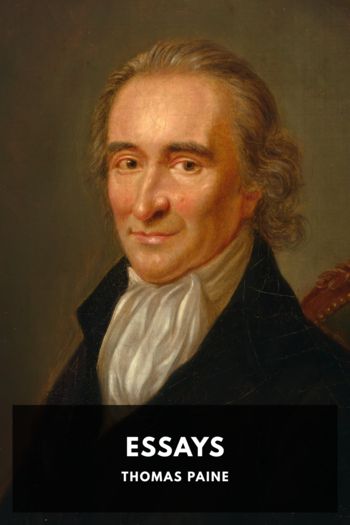The Age of Reason by Thomas Paine (icecream ebook reader TXT) 📕

- Author: Thomas Paine
Book online «The Age of Reason by Thomas Paine (icecream ebook reader TXT) 📕». Author Thomas Paine
French: la civilisation instead of “liberality.” —Conway ↩
The same school, Thetford in Norfolk, that the present Counsellor Mingay went to, and under the same master.92 ↩
The pamphlet “Common Sense” was first advertised, as “just published,” on January 10, 1776. His plea for the Officers of Excise, written before leaving England, was printed, but not published until 1793. Despite his reiterated assertion that “Common Sense” was the first work he ever published the notion that he was “Junius” still finds some believers. An indirect comment on our Paine-Junians may be found in Part II of this work where Paine says a man capable of writing Homer “would not have thrown away his own fame by giving it to another.” It is probable that Paine ascribed the Letters of Junius to Thomas Hollis. His friend F. Lanthenas, in his translation of The Age of Reason (1794) advertises his translation of the Letters of Junius from the English “(Thomas Hollis).” This he could hardly have done without consultation with Paine. Unfortunately this translation of Junius cannot be found either in the Bibliotheque Nationale or the British Museum, and it cannot be said whether it contains any attempt at an identification of Junius. —Conway ↩
This sentence is not in the French work. —Conway ↩
No doubt Paine’s aunt, Miss Cooke, who managed to have him confirmed in the parish church at Thetford. —Conway ↩
As this book may fall into the hands of persons who do not know what an orrery is, it is for their information I add this note, as the name gives no idea of the uses of the thing. The orrery has its name from the person who invented it. It is a machinery of clockwork, representing the universe in miniature: and in which the revolution of the earth round itself and round the sun, the revolution of the moon round the earth, the revolution of the planets round the sun, their relative distances from the sun, as the center of the whole system, their relative distances from each other, and their different magnitudes, are represented as they really exist in what we call the heavens. ↩
Allowing a ship to sail, on an average, three miles in an hour, she would sail entirely round the world in less than one year, if she could sail in a direct circle, but she is obliged to follow the course of the ocean. ↩
Those who supposed that the Sun went round the earth every twenty-four hours made the same mistake in idea that a cook would do in fact, that should make the fire go round the meat, instead of the meat turning round itself towards the fire. ↩
With reference to the omision of any mention of Uranus, see the Introduction. In the New York edition, 1794, edited by Col. John Fellows, occurs this footnote: “Mr. Paine had made no mention of the planet Herschel, which was first discovered, by the person whose name it bears, in 1781. It is at a greater distance from the Sun than either of the other planets and consequently occupies a greater length of time in performing its revolutions.” —Conway ↩
If it should be asked, how can man know these things? I have one plain answer to give, which is, that man knows how to calculate an eclipse, and also how to calculate to a minute of time when the planet Venus, in making her revolutions round the Sun, will come in a strait line between our earth and the Sun, and will appear to us about the size of a large pea passing across the face of the Sun. This happens but twice in about a hundred years, at the distance of about eight years from each other, and has happened twice in our time, both of which were foreknown by calculation. It can also be known when they will happen again for a thousand years to come, or to any other portion of time. As therefore, man could not be able to do these things if he did not understand the solar system, and the manner in which the revolutions of the several planets or worlds are performed, the fact of calculating an eclipse, or a transit of Venus, is a proof in point that the knowledge exists; and as to a few thousand, or even a few million miles, more or less, it makes scarcely any sensible difference in such immense distances. ↩
This speculation has been confirmed by nineteenth-century astronomy. “The stars, speaking broadly, are suns.” (Clarke’s System of the Stars, chapter III). See Herschel’s Outlines of Astronomy, Part III chapter XV. —Conway ↩
The French work has plusieurs planètes (“many planets”) instead of “six worlds.” —Conway ↩
The French work has triste. —Conway ↩
The French work has: leur mouvement mêmes est le premier éveil, la prèmiere instruction de la raison dans l’homme. (“Their motion itself is the first awakening, the first instruction of the reason in man.”) —Conway ↩
Such constant rebirth of the Son was the doctrine of the Master Eckhardt (4th cent.). —Conway ↩
In the French work: du verbe “croire.” —Conway ↩
“In the childhood of the world,” according to the first (French) version; and the strict translation of the final sentence is: “Deism was the religion of Adam, supposing him not an imaginary being; but none the less must it be left to all men to follow, as is their right, the religion and worship they prefer.” —Conway





Comments (0)